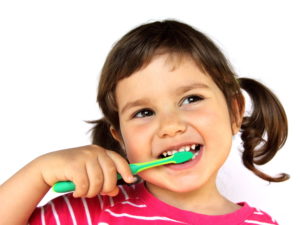You probably haven’t thought much about how you brush your teeth since you were first learning as a young child. However, there’s a good chance you’ve forgotten some of what you learned and developed some bad habits along the way. Even if you have small children of your own and you’re teaching them how to brush, you might not apply the same rules to yourself.
developed some bad habits along the way. Even if you have small children of your own and you’re teaching them how to brush, you might not apply the same rules to yourself.
When was the last time you listened to a tooth brushing song to make sure you spent two full minutes brushing your teeth? You make your kids do it, so what makes you think you’re exempt? The point is that we could all use a little refresher when it comes to properly practicing this essential oral hygiene activity. You might even learn something you didn’t know. Here are just a few of the most common mistakes you’ll want to avoid when it comes to brushing your teeth.
1. Using stiff bristles
This is a major no-no. Sure, you want to get your teeth as clean as possible, and it’s natural to assume that stiff bristles will do the job better than the soft and gentle approach. Unfortunately, stiffer bristles could be doing more harm than good.
While stiff bristles alone probably won’t damage your teeth (unless paired with abrasive toothpaste and/or incorrect brushing technique), they can definitely harm the soft tissue in your mouth, particularly your gums. Attacking your teeth with stiff bristles could mean your sensitive gums become collateral damage as they are irritated by the rough treatment.
Gums could become red, swollen, and tender when you mistreat them, and this could lead to discomfort or even more serious issues like abrasions and infection. In other words, it’s always best to rely on a soft bristle toothbrush and proper brushing technique.
2. Not replacing your toothbrush regularly
This is a mistake that a lot of people make. If you wait to get a new toothbrush until your dentist hands out a freebie at your checkup, you’re waiting too long. According to the American Dental Association, your toothbrush should be replaced about every 2-3 months, so even if you see the dentist for a cleaning and examination every 6 months, your old toothbrush is outdated. The efficacy of your brushing routine could suffer as a result, along with your oral health.
3. Brushing incorrectly
I know what you’re thinking – you’ve been brushing the same way since you were five – but it’s probably not true. As noted above, you likely don’t spend a full two minutes brushing anymore, and other aspects of your brushing may have become a little lax, as well.
Here’s a little refresher on how you should be brushing. You need to brush each tooth with a gentle, up-and-down motion and make sure to clean on all sides. If you’re brushing in circles, brushing back and forth (i.e. horizontally), or brushing with way too much gusto (i.e. brushing too hard), you could not only be missing spots on and between teeth, but you could also be causing damage to your gums.
This, in turn, could lead to issues like tooth decay, gum disease, and receding gum line. If you’re not certain you’re brushing properly, simply ask your dentist for a quick refresher course the next time you go in for a cleaning. He/she will be happy to help and your oral health will improve as a result.
4. Not brushing your tongue
Okay, technically this is not part of brushing your teeth, but a failure to address the soft tissue in your mouth could have a major impact on the health of your teeth, so it’s definitely worth noting, especially since so many people make this error. Your tongue is a breeding ground for bacteria that can cling to teeth and form plaque and tartar, leading to serious issues like tooth decay and gum disease. Make sure to brush your tongue every time you brush your teeth to eliminate as much food and bacteria as possible.
5. Skipping the floss and rinse
Again, these tasks aren’t part of brushing, but if you want to make the most of your efforts to maintain a clean and healthy mouth, they are essential. Flossing gets at food between teeth and below the gum line that your toothbrush can’t reach, and mouthwash flushes away lingering food and bacteria to ensure the best possible oral health.

